House steward - Keishi

|
Officials in charge of household affairs for princes, regents, and ministers. Also called "iezukasa". According to the Yoro Personnel Order, princes of high rank and those with the rank of third rank or higher were provided with officials in charge of household affairs, such as keryo, fu, dai and shoju, and shoshoshi, depending on their rank and rank, and the Taiho Code was thought to have been similar. These were officials designated by the Kani Code, and the head of the government would evaluate their performance every year according to the methods of the various offices and send the results to the Ministry of Ceremonies. These officials below the rank of keseki were collectively called keshi. After the Heian period, as the ritsuryo system gradually declined and the power of powerful families increased, officials outside the ritsuryo appeared and the organization of household affairs institutions became more complex. According to the Gokeshidai and other sources, the Imperial Prince's family had such officials as the Chief Administrator, House Steward, Shikiji, Attendant, Gogen, Kurodo, and other household administrative institutions such as the Mandokoro, Kurando, and Samuraidokoro. Also, according to the Shoyuki and other sources, the family of Fujiwara Sanesuke, the Minister of the Right, had non-ritual officials such as the House Steward, Chikeji, Anzu, and Suito in the Mandokoro, in addition to the Ritsuryo officials below the rank of House Steward, and it is clear that in addition to the Mandokoro, they also had the Samuraidokoro, Umayanotsukasa, Zuijindokoro, and Zosikidokoro. These officials were collectively called kaseshi, but the kareishi and betto were sometimes called kami kaseshi and those below them were called shimo kaseshi. The center of household administration was the mandokoro, which issued kacho (family certificates) and negotiated with various government offices, and also managed the family estate through kafu (family seals) and kudashibumi (mandokoro documents), and the issuance of these documents was also handled by the kaseshi. [Yutaro Yanagi] Source: Shogakukan Encyclopedia Nipponica About Encyclopedia Nipponica Information | Legend |
|
親王および摂関・大臣家などの家政をつかさどる職員。「いえづかさ」ともいう。養老職員令(ようろうしきいんりょう)によると、有品(ゆうほん)親王および職事三位(しきじさんみ)以上には、その品(ほん)・位(い)に応じて、家令(けりょう)、扶(ふ)、大・少従(じゅう)、大・少書吏(しょり)など家政をつかさどる職員が付属する規定であり、大宝(たいほう)令もほぼ同じであったと考えられる。これらは官位令に定められた職事官であり、毎年本主が諸司の考法に準じて勤務成績を評定し、式部省に送る定めであった。これら家令以下の職員を総称して家司ともいった。平安時代以降、令制がしだいに衰退し権勢家の勢力が増大するに伴い、令外(りょうげ)の職員が現れ、家政機関の組織も複雑化した。親王家については、『江家次第(ごうけしだい)』などによると、勅別当(ちょくべっとう)、家司、職事、侍者(じしゃ)、御監(ごげん)、蔵人(くろうど)などの職員が置かれ、また政所(まんどころ)、蔵人所、侍所(さむらいどころ)などの家政機関が設けられた。また『小右記(しょうゆうき)』などによると、右大臣藤原実資(さねすけ)家には、家令以下の令制職員とともに、政所に家司、知家事(ちけじ)、案主(あんず)、出納(すいとう)などの令外の職員が置かれ、政所のほかにも侍所、厩司(うまやのつかさ)、随身(ずいじん)所、雑色(ぞうしき)所などが設けられたことが明らかにされている。これらの職員を総称して家司ともいったが、さらに家令、別当を上(かみ)家司、それ以下を下(しも)家司と称することもあった。家政の中心は政所であり、政所は家牒(かちょう)を発行して諸官司と折衝し、また家符・政所下文(くだしぶみ)によって家領の経営などにあたったが、これらの文書の発給も家司がつかさどった。 [柳雄太郎] 出典 小学館 日本大百科全書(ニッポニカ)日本大百科全書(ニッポニカ)について 情報 | 凡例 |
>>: Calculation amount - calculation amount
Recommend
Chickenpox (Chickenpox)
What kind of infection is it? Chickenpox, a virus...
Brocky K.
…Bogdány Jakab (1660-1724) was already famous for...
Granulosa lutein cells - Lutein cells of the granulosa
…After ovulation, the follicle becomes loose and ...
sarāy (English spelling) saray
…(4) Tombs (qubba, gunbad, türbe, mashhad): These...
Ayers Rock
A rocky mountain located 440km (by road) southwest...
Whirlwind Leaf - Whirlwind Leaf
A binding method for Japanese and Chinese old boo...
Kujo style
〘 noun 〙 A leading school of court etiquette and c...
Umineko (sea cat) - Umineko (English spelling) black-tailed gull
A seabird of the Laridae family (illustration). It...
Camellia maliflora (English spelling)
…[Yoshiharu Iijima]. … *Some of the terminology t...
Vermilion (English spelling)
It occurs naturally as cinnabar. It is a red pigm...
Public gambling - Koueito Baku
Gambling and lotteries stimulate the spirit of spe...
Die Horen
The most important literary magazine of the German...
Demian, C. (English spelling)
...It is also called a hand organ. It was invente...
Six National Histories - Rikkokushi
A general term for six national histories compile...
Orestes
A hero in Greek mythology. Son of Agamemnon, comma...









